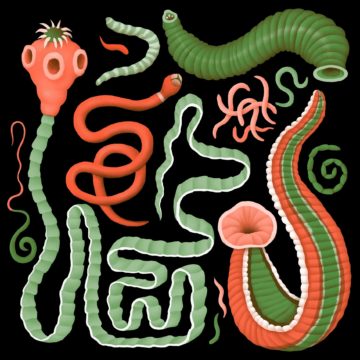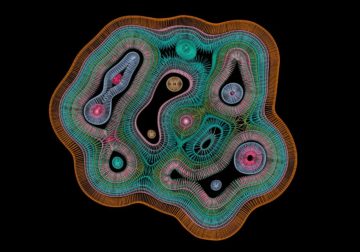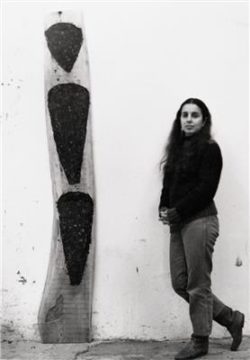Kathryn Hughes in The Guardian:
 What do you give the queen who has everything? When Mark Antony was wondering how to impress Cleopatra in the run-up to the battle of Actium in 31BC, he knew that jewellery would hardly cut it. The queen of the Ptolemaic kingdom of Egypt had recently dissolved a giant pearl in vinegar and then proceeded to drink it, just because she could. In the face of such exhausted materialism, the Roman general knew that he would have to pull out the stops if he was to win over the woman with whom he was madly in love. So he arrived bearing 200,000 scrolls for the great library at Alexandria. On a logistical level this worked well: since the library was the biggest storehouse of books in the world, Cleopatra almost certainly had the shelf space. As a romantic gesture, it was equally provocative. Within weeks the middle-aged lovers were embarked on the final chapter of their erotic misadventure, the one which would mark the beginning of the end both for them and for Alexandria’s fabled library.
What do you give the queen who has everything? When Mark Antony was wondering how to impress Cleopatra in the run-up to the battle of Actium in 31BC, he knew that jewellery would hardly cut it. The queen of the Ptolemaic kingdom of Egypt had recently dissolved a giant pearl in vinegar and then proceeded to drink it, just because she could. In the face of such exhausted materialism, the Roman general knew that he would have to pull out the stops if he was to win over the woman with whom he was madly in love. So he arrived bearing 200,000 scrolls for the great library at Alexandria. On a logistical level this worked well: since the library was the biggest storehouse of books in the world, Cleopatra almost certainly had the shelf space. As a romantic gesture, it was equally provocative. Within weeks the middle-aged lovers were embarked on the final chapter of their erotic misadventure, the one which would mark the beginning of the end both for them and for Alexandria’s fabled library.
In this generous, sprawling work, the Spanish historian and philologist Irene Vallejo sets out to provide a panoramic survey of how books shaped not just the ancient world but ours too. While she pays due attention to the physicality of the book – what Oxford professor Emma Smith has called its “bookhood” – Vallejo is equally interested in what goes on inside its covers. And also, more importantly, what goes on inside a reader when they take up a volume and embark on an imaginative and intellectual dance that might just change their life. As much as a history of books, Papyrus is also a history of reading.
More here.

 A vacation in the Catskills, one of those beautiful summer days which seem to go on forever, with family friends down at a local pond. I must have been six. I waded around happily, in and out of the tall grasses that grew in the murky water, but when I emerged onto the shore my legs were studded with small black creatures. “Leeches! Don’t touch them!” my mother yelled. I stood terrified. My parents’ friends lit cigarettes and applied the glowing ends to the parasites, which exploded, showering me with blood.
A vacation in the Catskills, one of those beautiful summer days which seem to go on forever, with family friends down at a local pond. I must have been six. I waded around happily, in and out of the tall grasses that grew in the murky water, but when I emerged onto the shore my legs were studded with small black creatures. “Leeches! Don’t touch them!” my mother yelled. I stood terrified. My parents’ friends lit cigarettes and applied the glowing ends to the parasites, which exploded, showering me with blood. Technological advances such as Elon Musk’s Neuralink device are meant to be implanted in people’s skulls to interface their brain with powerful computers via the internet. Neuralink’s device will be designed to bring information to subjects’ minds and, possibly, to help subjects acquire skills. If the device works as intended, we will be able to acquire information via a device that is not a natural part of us. Will the acquisition of this information give us knowledge? Will we really know how to do whatever it is that Neuralink’s device assists us in doing? How we answer these questions is important. Knowledge is, arguably, an important human achievement, and if Neuralink’s device (or some other technological assistance) makes it so that we acquire information without knowing, or if it makes it so we do not know how to do what we do as a result of the technological assistance, then we have thereby reduced our ability to succeed in ways important to our humanity. Further, knowledge is arguably required for moral action. Performing a charitable act in full knowledge (and knowing how to perform the act) is more praiseworthy than performing the act in ignorance. If, however, our reliance on new technology diminishes our ability to act knowledgably, then we are less praiseworthy for having relied on that technology.
Technological advances such as Elon Musk’s Neuralink device are meant to be implanted in people’s skulls to interface their brain with powerful computers via the internet. Neuralink’s device will be designed to bring information to subjects’ minds and, possibly, to help subjects acquire skills. If the device works as intended, we will be able to acquire information via a device that is not a natural part of us. Will the acquisition of this information give us knowledge? Will we really know how to do whatever it is that Neuralink’s device assists us in doing? How we answer these questions is important. Knowledge is, arguably, an important human achievement, and if Neuralink’s device (or some other technological assistance) makes it so that we acquire information without knowing, or if it makes it so we do not know how to do what we do as a result of the technological assistance, then we have thereby reduced our ability to succeed in ways important to our humanity. Further, knowledge is arguably required for moral action. Performing a charitable act in full knowledge (and knowing how to perform the act) is more praiseworthy than performing the act in ignorance. If, however, our reliance on new technology diminishes our ability to act knowledgably, then we are less praiseworthy for having relied on that technology. Alden B. Dow is remembered today as a talented architect who adapted Wrightian principles to design modern homes for the midcentury good life, many in his hometown of Midland, Michigan. But Dow was also a prolific amateur filmmaker who ultimately wished to be remembered as a philosopher (fig. 1). Some of his better-known films include two made at Wright’s Taliesin—a black and white film, shot during Dow’s apprenticeship with the master in 1933 and a stunning Kodachrome film of a 1946 trip with his wife to Taliesin West in Arizona, featuring rare footage of Wright himself (fig. 2). These films, which have circulated largely in the service of Wright’s fame as an architect, theorist, and teacher, are just a tiny fraction of the approximately three hundred films produced by Alden Dow from 1923 through the 1960s: travel films and home movies, but also philosophically-oriented experimental films and a host of architectural films. To honor Dow’s legacy and career, some of them are regularly screened today in a small 16mm theater of the architect’s own design in the basement of the Alden B. Dow Home and Studio in Midland, Michigan, as part of that institution’s public outreach and educational mission. Preserved in the archive, the films survive to exemplify the singular creative vision and, yes, philosophy of their maker.
Alden B. Dow is remembered today as a talented architect who adapted Wrightian principles to design modern homes for the midcentury good life, many in his hometown of Midland, Michigan. But Dow was also a prolific amateur filmmaker who ultimately wished to be remembered as a philosopher (fig. 1). Some of his better-known films include two made at Wright’s Taliesin—a black and white film, shot during Dow’s apprenticeship with the master in 1933 and a stunning Kodachrome film of a 1946 trip with his wife to Taliesin West in Arizona, featuring rare footage of Wright himself (fig. 2). These films, which have circulated largely in the service of Wright’s fame as an architect, theorist, and teacher, are just a tiny fraction of the approximately three hundred films produced by Alden Dow from 1923 through the 1960s: travel films and home movies, but also philosophically-oriented experimental films and a host of architectural films. To honor Dow’s legacy and career, some of them are regularly screened today in a small 16mm theater of the architect’s own design in the basement of the Alden B. Dow Home and Studio in Midland, Michigan, as part of that institution’s public outreach and educational mission. Preserved in the archive, the films survive to exemplify the singular creative vision and, yes, philosophy of their maker. In 1844, a Nashville gentleman named Return Jonathan Meigs was placidly reading Francis Bacon in the evening when he suddenly slammed the book shut and, in the presence of his startled fourteen-year-old son,
In 1844, a Nashville gentleman named Return Jonathan Meigs was placidly reading Francis Bacon in the evening when he suddenly slammed the book shut and, in the presence of his startled fourteen-year-old son,  For years I’ve interacted with people who seem to agree with me on the issues—the government should fund technology policy, nuclear energy is good, not bad, economic growth can drive positive-sum improvements for humans and nature, environmental activists are kind of full of shit—but who, when pressed, stop short of fully endorsing ecomodernism as a philosophy or a project. And while we at the Breakthrough Institute have done our best to set up ecomodernism as a “big tent,” inclusive of all sorts of ideological backgrounds and merely “ecomodern-ish” folks, many of these people have left me puzzled. Even discounting the fact that most people will not take as enthusiastically to ecomodernism as I do, it just seems obvious to me that many more of these people should get on board than have done so to date.
For years I’ve interacted with people who seem to agree with me on the issues—the government should fund technology policy, nuclear energy is good, not bad, economic growth can drive positive-sum improvements for humans and nature, environmental activists are kind of full of shit—but who, when pressed, stop short of fully endorsing ecomodernism as a philosophy or a project. And while we at the Breakthrough Institute have done our best to set up ecomodernism as a “big tent,” inclusive of all sorts of ideological backgrounds and merely “ecomodern-ish” folks, many of these people have left me puzzled. Even discounting the fact that most people will not take as enthusiastically to ecomodernism as I do, it just seems obvious to me that many more of these people should get on board than have done so to date. American culture feels dangerously stuck and stilted these days. Many of our best and brightest look for all the world as if they were standing at the tail end of something, equipped with resources fit for a bygone reality, at loose ends in this one. In a perfect bit of performance poetry—who says mass societies can’t be poetical?—we keep cycling through the halls of leadership a cast of tottering, familiar, reassuring grandparents, who spend their tenures insider-trading and murmuring hits from the old boomer songbook, desperately hoping that no cameras are running when they nod off, just a skosh, into their salad, or tip over their mountain bikes, ever so gingerly. Our president turns eighty in November, and he is vowing to run again. We have no new ideas for America. The best in our culture lack all conviction, while the worst are full of passionate intensity (approximately). A soft apocalypticism seems to be in the water.
American culture feels dangerously stuck and stilted these days. Many of our best and brightest look for all the world as if they were standing at the tail end of something, equipped with resources fit for a bygone reality, at loose ends in this one. In a perfect bit of performance poetry—who says mass societies can’t be poetical?—we keep cycling through the halls of leadership a cast of tottering, familiar, reassuring grandparents, who spend their tenures insider-trading and murmuring hits from the old boomer songbook, desperately hoping that no cameras are running when they nod off, just a skosh, into their salad, or tip over their mountain bikes, ever so gingerly. Our president turns eighty in November, and he is vowing to run again. We have no new ideas for America. The best in our culture lack all conviction, while the worst are full of passionate intensity (approximately). A soft apocalypticism seems to be in the water. As a grad student in cell biology,
As a grad student in cell biology,  What exactly is an “oral history,” and why would we need one? Most history begins and ends with personal witness, and even written documents, after all, were very often once spoken memories, with many of the best histories depending on recollected conversation, from Boswell’s life of Dr. Johnson to the court memoirs of Saint-Simon. Yet the term has become so much a part of our book culture that it tells us to expect something very specific: a heavily edited chain of first-person recollections, broken into distinct related bits, about a place or a system or an event. Although the contemporary version has roots in the oral histories compiled by the W.P.A. in the nineteen-thirties, it seems to derive, in form, from documentary films of the sixties like those of D. A. Pennebaker and Richard Leacock, in which testimony is offered in sequential counterpoint, without explicit commentary.
What exactly is an “oral history,” and why would we need one? Most history begins and ends with personal witness, and even written documents, after all, were very often once spoken memories, with many of the best histories depending on recollected conversation, from Boswell’s life of Dr. Johnson to the court memoirs of Saint-Simon. Yet the term has become so much a part of our book culture that it tells us to expect something very specific: a heavily edited chain of first-person recollections, broken into distinct related bits, about a place or a system or an event. Although the contemporary version has roots in the oral histories compiled by the W.P.A. in the nineteen-thirties, it seems to derive, in form, from documentary films of the sixties like those of D. A. Pennebaker and Richard Leacock, in which testimony is offered in sequential counterpoint, without explicit commentary. HERE IS WHAT WE KNOW: In 1979, Ana Mendieta, a young, up-and-coming artist fresh off a solo show at the feminist co-op A.I.R. Gallery, met the older, more famous Carl Andre, a so-called founding father of Minimalism. The artists embarked on a romantic and, by several accounts, tempestuous relationship. In 1985, Mendieta died after falling from the window of Andre’s thirty-fourth-floor apartment in New York’s Greenwich Village. He was tried, and acquitted, for her murder. Now eighty-seven, Andre—still living, somewhat astoundingly, in that same apartment—has carried on with his career, exhibiting regularly in museums and galleries throughout the world. Yet not everyone is convinced of his innocence, as we hear in Death of an Artist, a six-episode podcast from writer-curator Helen Molesworth. In addition to offering a précis on the defects of the US justice system, the series reframes abiding questions about art through the lens of Mendieta’s case: Are artists’ lives—and deaths—relevant when discussing their work? What about when we suspect that they have committed a terrible crime? Who benefits from silence, and from speaking up?
HERE IS WHAT WE KNOW: In 1979, Ana Mendieta, a young, up-and-coming artist fresh off a solo show at the feminist co-op A.I.R. Gallery, met the older, more famous Carl Andre, a so-called founding father of Minimalism. The artists embarked on a romantic and, by several accounts, tempestuous relationship. In 1985, Mendieta died after falling from the window of Andre’s thirty-fourth-floor apartment in New York’s Greenwich Village. He was tried, and acquitted, for her murder. Now eighty-seven, Andre—still living, somewhat astoundingly, in that same apartment—has carried on with his career, exhibiting regularly in museums and galleries throughout the world. Yet not everyone is convinced of his innocence, as we hear in Death of an Artist, a six-episode podcast from writer-curator Helen Molesworth. In addition to offering a précis on the defects of the US justice system, the series reframes abiding questions about art through the lens of Mendieta’s case: Are artists’ lives—and deaths—relevant when discussing their work? What about when we suspect that they have committed a terrible crime? Who benefits from silence, and from speaking up? Children do not tend to feature prominently in the satirical works of the ‘Prince of Caricatura’, James Gillray. As someone professionally committed to excoriating the politicians and celebrities of his day, he was paid to train his eye on the grown-ups. One exception to this rule comes in A March to the Bank, a vast, elaborate print of 1787. It was published in the wake of the anti-Catholic Gordon Riots in London and reflects the city’s outrage at the subsequent military crackdown on public disorder. Gillray blends straight portraiture with lurid exaggeration in his etching: an absurdly dandified, impossibly skinny officer goosesteps over a mob of Londoners, who lie crushed and abandoned in various states of disarray. At the centre of the picture, with the officer’s foot daintily poised on her midriff, lies the grotesque, ungainly figure of a fishwife, still grasping a basket of eels, her hefty legs splayed wide open. A fragment of cloth barely covers her genitals. Next to her lies a baby boy, perhaps her son, who is naked from the waist down and spread-eagled on the edge of the pavement. An impassive-looking soldier has placed the tip of his boot squarely on the child’s face.
Children do not tend to feature prominently in the satirical works of the ‘Prince of Caricatura’, James Gillray. As someone professionally committed to excoriating the politicians and celebrities of his day, he was paid to train his eye on the grown-ups. One exception to this rule comes in A March to the Bank, a vast, elaborate print of 1787. It was published in the wake of the anti-Catholic Gordon Riots in London and reflects the city’s outrage at the subsequent military crackdown on public disorder. Gillray blends straight portraiture with lurid exaggeration in his etching: an absurdly dandified, impossibly skinny officer goosesteps over a mob of Londoners, who lie crushed and abandoned in various states of disarray. At the centre of the picture, with the officer’s foot daintily poised on her midriff, lies the grotesque, ungainly figure of a fishwife, still grasping a basket of eels, her hefty legs splayed wide open. A fragment of cloth barely covers her genitals. Next to her lies a baby boy, perhaps her son, who is naked from the waist down and spread-eagled on the edge of the pavement. An impassive-looking soldier has placed the tip of his boot squarely on the child’s face. Orli Snir, a biologist at the Rockefeller University in New York, couldn’t keep her ants alive. She had plucked pupae from a colony of clonal raider ants, where the sesame seed-size offspring that looked like puffed rice cereal were being fussed over by both younger larvae and older adult ants. Then she had isolated each pupa into a tiny, dry test tube. And every time, they drowned. More specifically, each pupa was leaking so much watery, golden-tinted fluid it was struggling to breathe. But they lived when Dr. Snir whisked the fluid away with a capillary tube. Her humble observation led down a strange path of experiments toward a bizarre but inescapable conclusion: This mysterious ant goo functions a lot like milk.
Orli Snir, a biologist at the Rockefeller University in New York, couldn’t keep her ants alive. She had plucked pupae from a colony of clonal raider ants, where the sesame seed-size offspring that looked like puffed rice cereal were being fussed over by both younger larvae and older adult ants. Then she had isolated each pupa into a tiny, dry test tube. And every time, they drowned. More specifically, each pupa was leaking so much watery, golden-tinted fluid it was struggling to breathe. But they lived when Dr. Snir whisked the fluid away with a capillary tube. Her humble observation led down a strange path of experiments toward a bizarre but inescapable conclusion: This mysterious ant goo functions a lot like milk. For over a decade, scientists have been grappling with the alarming realization that many published findings — in fields ranging from psychology to cancer biology — may actually be wrong. Or at least, we don’t know if they’re right, because they just don’t hold up when other scientists repeat the same experiments, a process known as replication. In a 2015
For over a decade, scientists have been grappling with the alarming realization that many published findings — in fields ranging from psychology to cancer biology — may actually be wrong. Or at least, we don’t know if they’re right, because they just don’t hold up when other scientists repeat the same experiments, a process known as replication. In a 2015  In 1952, the Sight and Sound team had the novel idea of asking critics to name the greatest films of all time. The tradition became decennial, increasing in size and prestige as the decades passed.
In 1952, the Sight and Sound team had the novel idea of asking critics to name the greatest films of all time. The tradition became decennial, increasing in size and prestige as the decades passed. The magma that comes out of Mauna Loa comes from a series of magma chambers found between about 1 and 25 miles (2 and 40 km) below the surface. These magma chambers are only temporary storage places with magma and gases, and are not where the magma originally came from.
The magma that comes out of Mauna Loa comes from a series of magma chambers found between about 1 and 25 miles (2 and 40 km) below the surface. These magma chambers are only temporary storage places with magma and gases, and are not where the magma originally came from.